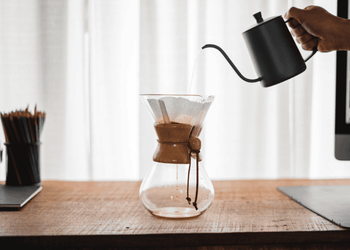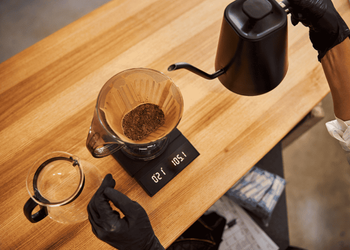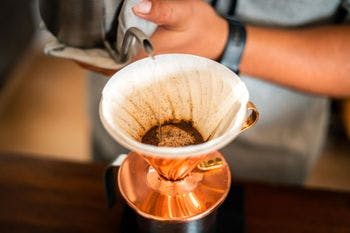
How to Make Coffee Without a Filter (10+ Effective Ways)

Do you often find your coffee getting gritty without filtration and end up spending dollars on coffee filters?
Don't worry! You're not alone.
But wait! What if I tell you that you can brew flavorful, sediment-free coffee even without a filter? How? Let's dive in.
In this blog, I will tell you how to make coffee without filter paper.
From cowboy coffee by the campfire to using a sock in a survival situation (yes, you read that right), I’ve got you covered.
Why make coffee with no filter?
1) Historical and cultural traditions
Brewing coffee without a filter takes you to the coffee's roots.
Just consider the traditional Turkish coffee made in a cezve or the rustic cowboy coffee brewed over a campfire. It's a journey through the cultural roots of vibrant coffee.
2) More convenient
When it comes to convenience filters aren't always available, especially when you're traveling. So, if you know how to brew coffee without using a coffee filter, it can be helpful when you need a quick caffeine fix but have minimal resources.
3) Reduced waste
If I talk about paper filters, they have a one-time use and once used, they are no more than an environmental waste.
So, if you avoid using them, you can do your part in reducing waste and adopting a more sustainable approach to coffee brewing.
4) Unique flavors
Brewing coffee without a filter can yield unique and robust flavors. Cowboy coffee, for example, is adored for its bold flavors.
5) Brewing simplified
Making coffee without a filter results in a quick and easy process reducing the steps.
12 ways to make coffee without filters
1) Cowboy Coffee
This coffee has a history that takes back to the time of the American Wild West and the cattle drives of the late 19th century.
Cowboys on cattle drives faced difficulty in brewing in unfavorable conditions.
Thus they got creative and tried brewing using a simple pot, coarsely ground coffee, and water from local sources. To brew a Cowboy coffee without using a filter:
Step 1
Begin by adding some water to the pot or pan. Add a little more water than usual. Let the water boil for some time.
Step 2
Add the coffee grounds. The ratio to follow is 1:4 where for every 2 tablespoons of ground coffee use 8 ounces of water.
Step 3
Once the coffee is boiled, you'll witness the grounds on top. Continue the boiling until the coffee grounds stop floating and settle at the bottom.
Once the ground settles at the bottom, your coffee will be ready to savor. Gently pour your coffee into the cup keeping the grounds aside.
2) French Press Method
The French press is also a handy tool that can aid when you run out of filters. It is simple enough.
To use a French press all you need is coarsely ground coffee beans, a French press, hot water, a stirring spoon, and a timer.
Step 1
Start by boiling water. Once it is warm enough add your coarsely ground coffee to the French press. The thumb rule is using a 1:15 coffee-to-water ratio where for every 1 ounce (28 grams) of coffee 15 ounces (450 milliliters) of water is taken. You can adjust the ratio as per your taste preferences.
Step 2
Now pour some water over the coffee grounds to soak them evenly. The first pour is known as the "bloom" where the coffee is degassed.
Step 3
After the first pour, wait for around 30 seconds and pour the rest of the hot water into the French press.
Step 4
Now take a stirring spoon and gently stir the coffee-water mixture. This step ensures uniform extraction.
Step 5
Once done, put the lid on the French press but don't press down the plunger. Set a timer for about 4 minutes and let the coffee steep.
Step 6
After 4 minutes, press down the plunger.
Your coffee is ready, savor it while reading a book or watching a movie.
3) Socks and Cloth
It might sound strange, but you can actually brew your coffee using a clean, tightly woven cloth or even a sock. You might be surprised by its simplicity and efficiency.
Just get some coarsely ground coffee beans, a clean, tightly woven cloth or a clean sock, a piece of string or twine, hot water (just off the boil), a stirring spoon, and a timer.
Step 1
Begin by using a clean cloth or sock. If you're using a sock, cut off the toe section to create a temporary bag.
Step 2
Now, put your coarsely ground coffee beans into the cloth or sock. Tie the open end of the cloth or sock tightly with a piece of string or twine, making sure that the coffee grounds are enclosed.
Step 3
Warm the water until it's just off the boil. Pour a small amount of hot water over the makeshift filter and let it soak or "bloom" for about 30 seconds. It will aid in releasing the coffee's natural gasses and make the grounds ready for brewing.
Step 4
After the bloom, pour the rest of the hot water over the coffee-filled cloth or sock.
Step 5
Take a stirring spoon to gently stir the mixture, ensuring that all the coffee grounds are saturated evenly.
Step 6
Place a lid or cover on top of your container, ensuring that the makeshift filter is fully immersed in the hot water. Set the timer to 4 minutes. This allows the coffee to steep.
Step 7
After the steeping time is up, remove the makeshift filter carefully. Here comes the strange but effective part: squeeze out your coffee from the cloth or sock into your cup. This process aids in separating the brewed coffee from the ground and makes your coffee ready to drink.
4) Eggshell Method
Ever heard of brewing coffee using an egg?
No! This is not any new experiment but indeed a technique used to brew coffee for ages. It works by using crushed eggshells that help coffee grounds settle at the bottom of the pot, effectively acting as a natural filter.
For this, all you need is:
- Coarsely ground coffee beans
- Crushed eggshells
- A pot or container
- Hot water (just off the boil)
- A stirring spoon
- A timer
Step 1
Start by mixing your coarsely ground coffee beans with the crushed eggshells. There's not any fixed ratio that you have to use, but you can experiment with different amounts to see what suits your taste. The eggshells will aid in filtering out the coffee grounds as they settle.
Step 2
Put the coffee and eggshell mixture into a pot or container feasible for the amount of coffee you want to brew.
Step 3
Warm the water until it's just off the boil. Gently pour the hot water over the coffee and eggshells. Begin with a small amount of water to initiate the "bloom" phase. This will allow the coffee to release its natural gasses and prepare the grounds for brewing. Let the mixture bloom for about 30 seconds.
Step 4
Once the blooming is complete, pour the rest of the hot water over the mixture, ensuring that all the coffee grounds are soaked completely. Take a stirring spoon and gently stir the mixture for uniform saturation.
Step 5
Cover your pot or container with a lid to retain the heat in, and set the timer for around 4 minutes. It will help the coffee to steep properly.
Step 6
Once the steeping time is done, carefully pour the coffee, making sure you do not disturb the grounds at the bottom. The crushed eggshells here will aid in trapping the coffee grounds as they settle, letting you pour a relatively filtered brew.
5) DIY Paper Filter
The DIY Paper Filter method is a creative way to make coffee without using traditional filters.
It is ideal for camping, traveling, or when you are just looking for a unique brewing experience, this method provides a simple and effective solution to brew a great cup of coffee.
For this, you will require:
- Coarsely ground coffee beans
- Filter paper
- A pour-over cone or holder
- Hot water (just off the boil)
- A timer
- A stirring spoon
Step 1
Begin by taking a piece of filter paper. Preference is it should be in a square or rectangular shape. If you have a circular piece, fold it in half to create a triangle shape.
Step 2
Now, take the triangle and fold it in half again, so you get a smaller triangle with one open end.
Step 3
Place the DIY paper filter into your pour-over cone or holder. Make sure the folded end is at the bottom and the open end is at the top.
Step 4
Put your coarsely ground coffee beans into the makeshift filter. The actual amount depends on your taste, but a common ratio of 1 to 2 tablespoons of coffee per 6 ounces of water is good to go.
Step 5
Pour a small amount of hot water over the coffee grounds. This initial pour phase is called the "bloom" phase. It allows the coffee to release gasses and prepares the grounds for brewing. Let the mixture bloom for around 30 seconds.
Step 6
Repeat the pour by adding some hot water in a steady, circular motion over the coffee grounds. Make sure you saturate all the grounds evenly. A gooseneck kettle will be perfect for better control.
Step 7
Take a stirring spoon and gently stir the mixture for uniform saturation.
Step 8
Put a lid or cover on top of your pour-over cone to retain the heat. Then, set your timer to 4 minutes and let your coffee steep.
Step 9
Once the steeping is done, your coffee is ready to savor.
6) Cheesecloth Filter
The Cheesecloth filter is a versatile and quick way to brew coffee when you lack traditional filters. Take some coarsely ground coffee beans, cheesecloth, a cup or container, hot water, a timer, and a stirring spoon.
Step 1
Begin by using a piece of cheesecloth. The size will vary as per the cup or container you take, but a square piece that's large enough to cover the opening is a great choice.
Step 2
Fold your cheesecloth into a square, and make sure there are enough layers to provide adequate filtration.
Step 3
Place the folded cheesecloth over your cup or container. make sure it's secure in its place, so it won't fall inside the cup.
Step 4
Put your coarsely ground coffee beans onto the center of the cheesecloth. The amount of coffee grounds will vary as per your taste preferences, but a common ratio is 1 to 2 tablespoons of coffee per 6 ounces of water is ideal.
Step 5
Start the brewing process by pouring hot water over the coffee grounds. Start with a small amount and let it soak or "bloom" for about 30 seconds. This step will release gasses from the coffee and prepare the grounds for brewing.
Step 6
After the bloom, continue pouring hot water over the coffee grounds in a steady, circular motion. Make sure that all the grounds are soaked well.
Step 7
Take a stirring spoon and gently stir the mixture, promoting uniform saturation.
Step 8
Put a lid or cover on top of your cup or container to maintain heat. Then, set your timer for around 4 minutes. It is the optimal steeping time for a well-extracted coffee.
Step 9
Once done your coffee is ready to enjoy. The cheesecloth filter will effectively separate the coffee grounds, resulting in a clean and flavorsome brew.
7) Metal Sieve
For this, all you need is
- coarsely ground coffee beans
- A fine-mesh metal sieve
- A cup or container
- Hot water (just off the boil)
- A timer
- And a stirring spoon
Step 1
Begin by choosing a fine-mesh metal sieve that can comfortably adjust on top of your cup or container. Make sure it's clean and free from any impurities.
Step 2
Put your coarsely ground coffee beans in the sieve. The amount of coffee grounds will depend on the taste you prefer, but a common ratio is 1 to 2 tablespoons of coffee per 6 ounces of water is ideal.
Step 3
Start the brewing process by adding hot water over the coffee grounds in the sieve. You can start with a small amount and let it soak or "bloom" for about 30 seconds. This step is crucial as it releases gasses from the coffee and prepares the grounds for brewing.
Step 4
Once the blooming is complete, continue pouring hot water over the coffee grounds in a steady, circular motion. Make sure that all the grounds that you have are evenly saturated.
Step 5
Take a stirring spoon and gently stir the mixture, promoting uniform saturation.
Step 6
Once the steeping process is complete, wait for around 4 minutes. It is the optimal steeping time for a well-extracted coffee. You can also set a timer to track the steeping time.
Step 7
After the steeping time, slowly take the sieve out of the cup or container and let the brewed coffee pass through while leaving the coffee grounds behind.
Step 8
Your coffee is now ready to enjoy.
8) Reusable Cloth Filters
Making use of a reusable cloth filter is a reliable choice that reduces waste and contributes to a greener environment.
To brew delectable cups using a reusable cloth filter you will require coarsely ground coffee beans, a reusable cloth filter, a pour-over cone or holder, hot water, a timer, a stirring spoon, a cup, or a container.
Step 1
Start by placing your reusable cloth filter in a clean pour-over cone or holder. Make sure the cloth filter is secured and doesn't have any wrinkles or folds that could affect your brewing process.
Step 2
Put some coarsely ground coffee beans into the cloth filter. The amount of coffee grounds will depend on your taste, but a common ratio is 1 to 2 tablespoons of coffee for every 6 ounces of water.
Step 3
Begin the brewing process by pouring hot water over the coffee grounds in the cloth filter. Add a small amount and let it soak for about 30 seconds. This step is vital as it releases gasses from the coffee and prepares the grounds for brewing.
Step 4
After blooming, continue pouring hot water over the coffee grounds in a steady, circular motion ensuring that all the grounds are evenly soaked.
Step 5
Take a stirring spoon to gently stir the mixture and promote uniform saturation.
Step 6
Once the steeping process is done, wait for around 4 minutes. This is the optimal steeping time for a well-extracted coffee. You can also set a timer to track the steeping time.
Step 7
Once done the brewed coffee will pass through the cloth filter and into your cup or container, leaving the coffee grounds behind.
Step 8
Your coffee is now ready to enjoy.
9) Improvised Pour-Over
Creating an improvised pour-over coffee without a filter is easier than you can imagine, especially if you have a container with a spout, such as a teapot.
This method allows you to enjoy a flavorful cup of coffee with readily available kitchen tools.
For this add some
- Coarsely ground coffee beans
- A container with a spout
- A fine-mesh strainer
- Hot water
- A timer
- A stirring spoon
- A cup or container to catch the brewed coffee
Step 1
Start by placing the fine-mesh strainer over the spouted container. Make sure it's positioned right to prevent any accidents.
Step 2
Put your coarsely ground coffee beans directly into the fine-mesh strainer. The amount of coffee grounds you select will depend on your personal preference, but a common ratio is 1 to 2 tablespoons of coffee per 6 ounces of water is ideal to use.
Step 3
Start the brewing process by pouring hot water over the coffee grounds in the strainer. Add a small amount, and let it soak for about 30 seconds. This step is crucial as it releases gasses from the coffee and prepares the grounds for brewing.
Step 4
Once the blooming is complete, continue pouring hot water over the coffee grounds in a steady, circular motion. Make sure that all the grounds are evenly saturated.
Step 5
Take a stirring spoon to gently stir the mixture, promoting uniform saturation. It will help to achieve an even extraction.
Step 6
Once the steeping process is complete, wait for around 4 minutes. Start the timer for precision.
Step 7
After the steeping time, the brewed coffee will pass through the fine-mesh strainer and into your cup or container, leaving the coffee grounds behind.
Step 8
Your improvised pour-over coffee is now ready to enjoy.
It is a convenient way to brew coffee without a filter when you don't have specialized tools in hand.
So, the next time you're craving a cup of coffee and don't have a filter, you can make use of your trusty container with a spout and a fine-mesh strainer to satisfy your coffee cravings.
10) Moka Pot
Moka pot is known for its rich and strong brew.
For this, you will require
- Coarsely ground coffee beans
- A Moka pot
- Hot water
- A stovetop
- A cup or container to catch the brewed coffee
Step 1
Begin by disassembling the Moka pot into its three parts: the bottom chamber (where we can add the water), the filter basket (where we put the coffee grounds), and the top chamber (where we collect the coffee after brewing). Fill the bottom chamber with some hot water. Add it up to the safety valve, making sure not to overfill.
Step 2
Place the coarsely ground coffee into the filter basket. You don't need a paper filter because the Moka pot relies on metal filtration. The amount of coffee grounds will vary as per the taste you prefer, but typically, it's around 1 to 2 tablespoons per 2 ounces of water.
Step 3
Reassemble the Moka pot by securing the filter basket filled with coffee grounds onto the bottom chamber. Make sure it's sealed properly.
Step 4
Put the Moka pot on the stovetop over medium heat. The heat will create pressure in the bottom chamber, and push hot water through the coffee grounds in the filter basket and into the top chamber.
Step 5
As the Moka pot heats up, you'll hear a gentle gurgling sound. This sound is an indicator that the brewing process is in progress. Pay attention to the process to ensure the coffee doesn't over-extract. When the gurgling sound diminishes, remove the Moka pot from the heat.
Step 6
The brewed coffee will be in the top chamber of the Moka pot. Pour it directly into your cup or container. Since the Moka pot doesn't require a paper filter, the rich, aromatic coffee flows through the metal filter basket, creating a flavorful and intense brew.
11) Turkish Coffee
Traditional Turkish coffee brewing works by settling fine grounds at the bottom of the cup, eliminating the need for a paper filter.
It's a unique, cultural way to relish strong, flavorful coffee.
Additionally, it allows you to customize the sweetness as per your taste and is a great option when you run out of paper filters.
Turkish coffee boasts a rich and strong flavor, and it's brewed without the need for a paper filter.
Here's how you can make coffee without a filter using the traditional Turkish coffee-making method:
Take some
- Finely ground coffee beans
- Cold water
- A small, long-handled pot called a cezve or ibrik
- Sugar (optional)
- A heat source
Step 1
Traditional Turkish coffee is strong enough, so begin by measuring the finely ground coffee. A standard measurement is one teaspoon (about 5-7 grams) per cup. You can adjust it as per your taste preferences.
Step 2
Pour some cold water into the cezve or ibrik, and then add sugar as per your taste. You can adjust the sugar as per your taste preferences but typically one to two teaspoons is enough.
Step 3
Stir the coffee into the water until it's mixed well. The main reason to mix the coffee with cold water is to prevent clumping when you heat it.
Step 4
Now put the cezve or ibrik over low heat and let it dissolve with the water. Stir at different intervals.
Step 5
As the mixture starts heating, you will observe the foam. Let it foam but make sure it doesn't overflow. You can lift it off the heat in between if it foams too much.
Step 6
Once the foam reaches the brim of the cezve or ibrik, remove it from the heat source. Pour a little foam into each demitasse cup, and then again put the cezve to the heat source to foam again.
Step 7
Repeat this process once or twice more, then pour the remaining coffee into the cups. As a result, you will have a cup of Turkish coffee with fine grounds settled at the bottom.
Step 8
Enjoy the aromatic Turkish coffee with some chocolate cookies.
12) French Drip Method
The French Drip method is a classic and time-tested method that allows you to explore your coffee with its full-bodied taste.
It is a fantastic way to brew coffee without the need for paper filters. For this, you will require
- Coarsely ground coffee beans
- A French drip pot
- Cold water
- A heat source
Step 1
Measure the coffee you want to brew. The general guideline is to use one heaping tablespoon (around 7-9 grams) of coffee for each cup of water. You can adjust the amount to your taste.
Step 2
The French drip pot consists of two chambers, one stacked on top of the other. The upper chamber has a metal mesh filter, and the lower chamber is where the brewed coffee is collected. Make sure the pot is clean and dry.
Step 3
Add the coarsely ground coffee into the upper chamber of the French drip pot, which contains the metal mesh filter. Make sure you don’t overfill it to allow room for the coffee to expand when it brews.
Step 4
Pour some cold water into the lower chamber of the French drip pot.
Step 5
Put the French drip pot on a heat source, such as a stovetop or an open flame. Adjust the heat to a level where the water is not boiling but warm enough.
Step 6
As the water heats and reaches the boiling point, it will rise through a tube from the lower chamber to the upper chamber, saturating all the coffee grounds. The hot water will then slowly drip through the metal mesh filter, extracting the flavors.
Step 7
As the coffee drips into the lower chamber, it's ready to sip. Once you are done with brewing remove the French drip pot from the heat source after a few minutes.
Wrapping up
Here I have covered different ways to brew coffee without using a filter.
Now it’s your turn. Get your ingredients, pick your favorite method, and start experimenting.

I am a barista by profession hailing from NC. My journey began in my late teens when I started working as a barista in a local coffee shop. My passion for coffee quickly became evident as I immersed myself in the art of espresso extraction, latte art ...



